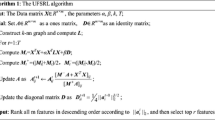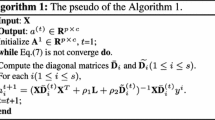Abstract
In this paper, a multiple sub-manifold learning method–oriented classification is presented via sparse representation, which is named maximum variance sparse mapping. Based on the assumption that data with the same label locate on a sub-manifold and different class data reside in the corresponding sub-manifolds, the proposed algorithm can construct an objective function which aims to project the original data into a subspace with maximum sub-manifold distance and minimum manifold locality. Moreover, instead of setting the weights between any two points directly or obtaining those by a square optimal problem, the optimal weights in this new algorithm can be approached using L1 minimization. The proposed algorithm is efficient, which can be validated by experiments on some benchmark databases.






Similar content being viewed by others
Explore related subjects
Discover the latest articles and news from researchers in related subjects, suggested using machine learning.References
Belkin M, Niyogi P (2003) Laplacian eigenmaps for dimensionality reduction and data representation. Neural Comput 15(6):1373–1396
Bengio Y, Paiement JF, Vincent P (2003) Out-of-sample extensions for LLE, Isomap, MDS, eigenmaps, and spectral clustering, Technical Report 1238, Universit′e deMontreal
Yan S, Xu D, Zhang B, Zhang HJ (2007) Graph embedding: a general framework for dimensionality reduction. IEEE Trans Pattern Anal Machine Intell 29(1):40–51
He X, Yang S, Hu Y, Niyogi P, Zhang HJ (2005) Face recognition using laplacianfaces. IEEE Trans Pattern Anal Machine Intell 27(3):328–340
He X, Niyogi P (2003) Locality preserving projections, in: advances in neural information processing systems 16 (NIPS 2003). Vancouver, Canada
Cai D, He X, Han J, Zhang H (2006) Orthogonal Laplacianfaces for face recognition. IEEE Trans Image Process 15(11):3609–3614
Yang J, Zhang D, Yang JY, Niu B (2007) Globally maximizing, locally minimizing: unsupervised discriminant projection with application to face and palm biometrics. IEEE Trans Pattern Anal Machine Intell 29(4):650–664
Deng W, Hu J, Guo J, Zhang H, Zhang C (2008) Comments on “globally maximizing, locally minimizing: unsupervised discriminant projection with application to face and palm biometrics”. IEEE Trans Pattern Anal Machine Intell 30(8):1503–1504
Li B, Wang C, Huang DS (2009) Supervised feature extraction based on orthogonal discriminant projection. Neurocomputing 73(1–3):191–196
Saul LK, Roweis ST (2003) Think globally fit locally: unsupervised learning of low dimensional manifolds. J Mach Learn Res 4:119–155
Roweis ST, Saul LK (2000) Nonlinear dimensionality reduction by locally linear embedding. Science 290:2323–2326
Wright J, Yang A, Sastry S, Ma Y (2009) Robust face recognition via sparse representation. IEEE Trans Pattern Anal Machine Intell 31(2):210–227
Li B, Huang DS, Wang C, Liu KH (2008) Feature extraction using constrained maximum variance mapping. Pattern Recogn 41(11):3287–3294
Tibshirani Robert (1996) Regression shrinkage and selection via the lasso. J Roy Stat Soc 58(1):267–288
Drori DD (2006) Solution of L1 minimization problems by LARS/Homotopy methods. ICASSP 3:636–639
Qiao L, Chen S, Tan X (2010) Sparsity preserving projections with applications to face recognition. Pattern Recogn 43(1):331–341
Yang M, Zhang L (2010) Gabor feature based sparse representation for face recognition with Gabor occlusion dictionary. ECCV, Crete
Zhang L, Yang M, Feng Z, Zhang D (2010) On the dimensionality reduction for sparse representation based face recognition. ICPR, Istanbul
Zhang H, Duan Z (2009) Symbolic algorithm analysis of rectangular hybrid systems. J Comput Sci Technol 24(3):1–15
Sim T, Baker S, Bsat M (2001) The CMU pose, illumination, and expression (PIE) database of human faces, Technical Report CMU-RI-TR-01-02, Robotics Institute, Carnegie Mellon University
Acknowledgments
This work was supported by the grants of the National Natural Science Foundation of China (61070013, 60703018, 61070012 & 90924026), 973 Program (2007CB310800), Twelfth Five Years Plan Key National Project (GFZX0101050302), 863 Program (2008AA022503, 2008AA01Z208, 2009AA01Z405), the Science and Technology Commission of Wuhan Municipality “Chenguang Jihua” (201050231058), the 111 Project (B07037), Natural Science Foundation of Hubei Province (2010CDB03302), Postdoctoral Science Foundation of China (20100470613), Shanghai Key Laboratory of Intelligent Information Processing, China (IIPL-2010-004), the Open Fund Project of State Key Laboratory of Software Engineering (Wuhan University, China, SKLSE08-11), and Science Foundation of Wuhan University of Science and Technology (2010XG7&2010XZ015).
Author information
Authors and Affiliations
Corresponding author
Rights and permissions
About this article
Cite this article
Liu, J., Li, B. & Zhang, WS. Feature extraction using maximum variance sparse mapping. Neural Comput & Applic 21, 1827–1833 (2012). https://doi.org/10.1007/s00521-010-0519-9
Received:
Accepted:
Published:
Issue Date:
DOI: https://doi.org/10.1007/s00521-010-0519-9




